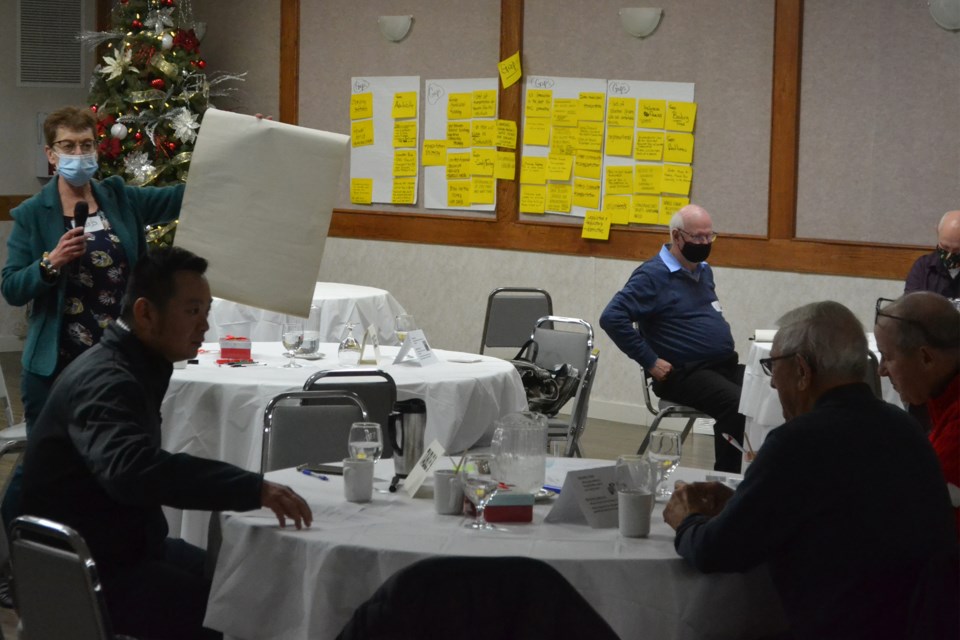OLDS — Organizers hope a focus group on how to improve transportation in the area will eventually lead to more funding for busing or other improvements for area residents.
About 50 people from across Mountain View County and neighbouring municipalities as well as Bowden attended the session that ran from 9:15 a.m. into the afternoon at the Royal Canadian Legion Branch #105.
Those attending represented municipalities in the area as well as other entities like church groups and service clubs.
The focus group was organized by the Age Friendly Initiative (AFI), which operates under the umbrella of the Olds Institute’s Community Lifestyles committee.
Organizers included AFI chair Erica Sweetman as well as committee members Rita Thompson and Bernice Lynn. Thompson spoke to The Albertan about the event.
Che-Wei Chung, a policy director for Alberta Municipalities who used to work in Olds also attended.
Thompson said the plan now is for all the information and concerns obtained during the session to be synthesized into a report which will be distributed to all the participants.
Organizers want to develop a strategic action plan to solve issues identified.
Plans also call for resolution to be drawn up to be presented during Alberta Municipalities and Rural Municipalities of Alberta conventions next fall.
The goal is to obtain provincial funding to improve transportation in rural areas like Olds, Mountain View County and adjacent areas.
Thompson said other solutions might include bringing “some health care services back to the community so people don’t have to drive to those services.”
She said right now, funding for transportation tends to go to bigger centres like Calgary, Edmonton and Red Deer.
"We identified the gaps. And then we examined the existing resources. And then, after that, we had a facilitated discussion on determining solutions for closing the gaps,” Thompson said.
“What's required for all of that is that there is collaboration and cooperation between the municipalities in the county to get it.”
Thompson said one example of the transportation issues identified is that the Sunshine Bus, which can transport disabled people, only runs from 9 a.m. to 4 p.m. Monday to Friday and must be booked one to two days in advance.
That doesn't always coincide with residents’ needs. Some people need to get to places like medical clinics earlier or may want to go out after working hours.
Also generally speaking, taxis aren’t equipped to readily handle wheelchairs, for example.
Thus, elderly or disabled residents often have little choice but to take a taxi as far as Calgary or Red Deer for appointments and that can be extremely expensive.
Research done by an intern for the Town of Olds this year found that some communities in Alberta with populations under 12,000 do offer in-town and inter-community transportation in vehicles ranging from vans to buses.
For example, the Blackfalds on-demand in-town service operates Monday to Friday from 6 a.m. to 8 p.m. Regional service is also provided. Its cost is subsidized as a part of property tax and sponsorship is shared with the city of Lacombe.
Thompson said transportation is “not just about wheels.”
She noted that a couple of years ago, surveys in Olds indicated problems with street crossings where buttons to cross crosswalks were too high for people on wheelchairs or shorter people, the time allowed to cross them was too short and sidewalks weren’t always graded well for wheelchair users.
Those issues were taken to Olds council and Thompson has noticed that since then, many of those problems have been rectified. That’s not always true in all communities.
She also pointed out that the lack of convenient transportation and its cost is not just an issue for the elderly or disabled. It's also a problem for low-income people, especially if they live far from places they have to get to.
Yet another issue is ensuring that there’s enough ridership to make bus or other forms of transportation viable in rural communities.
Also, insurance is very expensive for private sector transportation firms.
Planning ahead is key. Thompson said statistics show that each community of Mountain View region has a greater median age than the province. So as residents of those communities get older, the need for transportation to accommodate them only get greater.
The coming wave of electric vehicles is also a concern.
Currently, Thompson knows of only one electric vehicle charging station, located outside what is now the O-NET building at 51st Street and 51st Avenue. Many more will be needed if electric vehicles start showing up in the area in big numbers.
She cited the example of a condo that had no plug-ins in its underground garage. That became a problem when a couple of condo residents bought electric scooters and had no place to plug them in.
"Where are they (electric vehicle charging stations) going to be and who’s going to pay for it and where’s the electricity going to come from,” Thompson asked.
“So that’s just a sign of things to come. And how can we be proactive about planning for that in our community?”
Transportation issues are complex, Thompson said.
"It’s a huge – it’s an octopus with many arms. And it requires intelligent planning – not knee-jerk. So we need to be proactive and be thoughtful about what the needs are in our communities -- and work together. If we don’t work together, this won’t work," she said.



